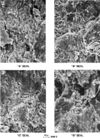Scanning electron microscopy (SEM)
Revision as of 17:33, 4 February 2014 by Cwhitehurst (talk | contribs)
Scanning electron microscopy is simply the process of using a scanning electron microscope.
The scanning electron microscope became available commercially in the mid 1960s and is used by geologists to study pore geometry and diagenetic history in order to evaluate type, distribution, and flow of fluids in the lithosphere. The SEM is useful for examining the effect of fluids and chemical additives on rocks during enhanced oil recovery.[1]
Figure 9 shows images from an SEM.[2] These images are SEM photomicrographs of seal types.
This article is a stub. You can help AAPG Wiki by expanding it.
Examples of use
- Camp, W.K, E. Diaz, and B. Wawak, eds., Electron Microscopy of Shale Hydrocarbon Reservoirs: AAPG Memoir 102, 260 pp.
References
- ↑ Thomas, John B., and Edward D. Pittman, 1979, Applications of scanning electron microscopy to hydrocarbon exploitation: AAPG Bulletin, v. 63 No. 3, p. 539.
- ↑ Snider, Robert M., John S. Sneider, George W. Bolger, and John W. Neasham, 1997, [Comparison of seal capacity determinations: Conventional cores vs. cuttings, in Surdam, R. C., ed., Seals, Traps, and the Petroleum System: AAPG Memoir 67, pp. 1-12.
